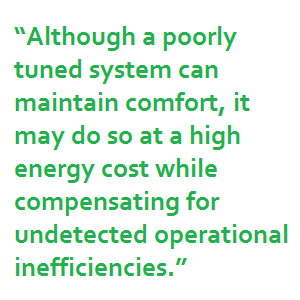
Not surprisingly, commercial buildings account for about 20% of the total energy consumption in the United States. What is surprising is that as much as 20% of the energy in these buildings is wasted because of improper operations. As a business owner or facility manager, this cannot go over well.
While many commercial buildings utilize sophisticated building automation systems (BASs) to manage building systems, many buildings are still not properly commissioned, operated, or maintained. This leads to inefficient operation, costly breakdowns, and high energy costs. The solution: re-tuning building automation systems (BASs).
By re-tuning commercial buildings, you ensure maximum energy efficiency and comfort for building occupants, as well as reduced energy costs.
What is Re-tuning?
Implemented primarily through the building control system, re-tuning is a systematic process used to identify and correct operational problems in commercial buildings, problems that could lead to energy waste.
- Includes small, low-cost repairs (like replacing faulty sensors)
- Identifying additional opportunities for energy savings
Common problems found during re-tuning include equipment running during unoccupied periods, heating/cooling set points too close, economizer problems, lack of resets on distribution loops for hot and chilled water, occupied schedules running longer than needed, discharge-air set points too low, static pressure too high, and more.
The Re-tuning Process
- Collect initial building information
- Trend data collection and analysis
- Building walk down
- Identify and correct operations problems
- Report retuning findings
- Determine and report the saving impact from re-tuning
Focus Areas in the Re-tuning Process
- Occupancy scheduling
- Discharge-air temperature control
- Discharge-air static pressure control
- Air-handling unit (AHU) heating &cooling
- AHU outside/fresh air makeup
- AHU economizer operation
- Zone conditioning
- Meter profiles: whole building electricity and gas consumption
- Central plant
What are the Benefits of Re-tuning Commercial Buildings?
- Improve a building’s energy efficiency
- Identify opportunities to further increase energy efficiency
- Identify problems requiring physical repair
- Often no cost other than the labor required to perform the re-tuning process
Re-tuning commercial buildings can yield energy savings from 5 to 20%
For more Energy Efficiency and Cost Savings Tips for HVAC Systems in Commercial Buildings or for more on Re-tuning Commercial Buildings, please contact Crockett Facilities Services by calling 301.262.2771 or email us at sales@crockett-facilities.com. Like us on Facebook; follow us on LinkedIn, Twitter, and Google+.
Source:
A Low-Cost Path to Energy Efficiency and Cost Savings Pacific Northwest National Laboratory
